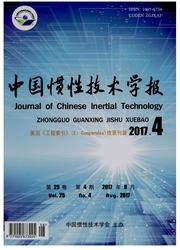

 中文摘要:
中文摘要:
研究了静基座捷联惯导系统初始失准角为大角度时扩展集员滤波在初始对准中的应用。给出了扩展集员滤波算法的基本概念和递推公式,指出算法假设系统的过程和量测噪声以及初始状态由已知椭球来定界,利用椭球集合来描述系统真实状态的可行集。算法在将非线性方程线性化过程中保留高阶项,利用区间分析方法对高阶项进行定界,然后加入到噪声项中,形成一个虚拟噪声项,对经过处理后的线性化方程进行集员滤波处理。最后将扩展集员滤波应用于惯导系统大失准角时的初始对准中,通过计算机仿真对比了扩展卡尔曼滤波和扩展集员滤波的估计效果。仿真结果表明,在随机噪声和有界噪声条件下,扩展集员滤波都较扩展卡尔曼滤波的效果要好,特别是当系统存在有界噪声,应用扩展卡尔曼滤波得到的效果已明显变差,但应用扩展集员滤波仍能得到比较好的结果。
 英文摘要:
英文摘要:
The principle and the recursive formula of ESMF were presented. The algorithm employed ellipsoidal outer approximation of feasible set, assuming that instantaneous process, observation noise vectors and the initial state were bounded by known ellipsoids. We retained the higher order when the equation was linearization, bound the higher order using interval analysis, and added to the noise vector. The set-membership filter(SMF) was used to process the linearization equation. Finally, the ESMF was employed to estimate the SINS alignment on static base, and the simulation result was used to compare with that of EKE The results show that the ESMF is more accurate than that of EKF in estimation precision under the cases of stochastic noise and bounded noise. The results are also accurate with the ESMF compared with the poor result of EKF, especially when the system has bounded noises.
 同期刊论文项目
同期刊论文项目
 同项目期刊论文
同项目期刊论文
 期刊信息
期刊信息
